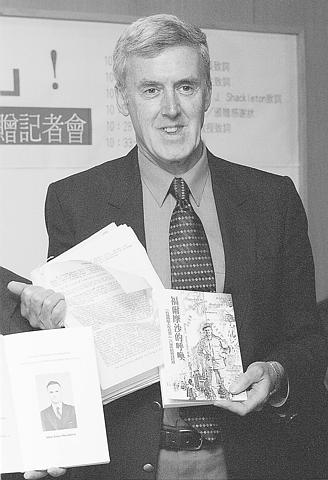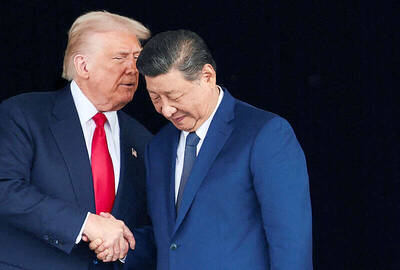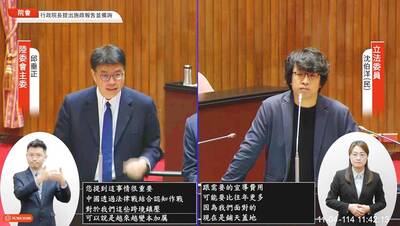The son of a New Zealander donated his father's manuscript titled Formosa Calling, Chronicle of Taiwan's 2-28 Incident, to the 228 Memorial Museum in Taipei yesterday, on the eve of the 53rd anniversary of the 1947 massacre.
"It's a great pleasure to donate this manuscript to the people of Taiwan. If my father were here today, I am sure he would be greatly honored," said 63-year-old Colin Shackleton at a ceremony held in the 228 Memorial Museum.
Also donated to the museum were his father's photos taken during his stay in Taiwan from 1946 to 1947, and the typewriter he used to produce the manuscript.

PHOTO: CHIANG YING-YING, TAIPEI TIMES
At the ceremony, Lap Phok-bun (
"It's a very moving moment," said Colin Shackleton.
Allan James Shackleton wrote the manuscript about his post-war experiences in Taiwan as a UN rehabilitation officer. A portion of the manuscript focuses on his eye witness accounts of the 1947 tragedy, detailing atrocities that took place in southern Taiwan.
"He was concerned about the unfortunate things that took place at that time. But unfortunately nobody would publish the book, so the manuscript was simply a family file for almost 50 years," Colin Shackleton said.
It was not until 1998 that the original English version was published. Last June, the Mandarin version of the book was published in Taiwan. Wu Mi-cha (吳密察), a historian on Taiwan history at the National Taiwan University, said Shackleton's account of the massacre was of great value to researchers.
"Shackleton's book is a precious historic record made by a foreigner, a third party who wrote about what he saw merely out of conscience, an account that had nothing to do with his personal interest," Wu said.
The 228 Incident refers to the KMT's bloody crackdown on civilian demonstrations in 1947 that followed an incident in Taipei on Feb. 28 of that year. KMT-Led troops, who had retreated to Taiwan from China two years before after losing the Chinese Civil War, carried out a crackdown which led to the slaughter of tens of thousands of Taiwanese. The massacre is said to have wiped out almost all of Taiwan's intellectual middle class.
Stanley Liao (
"Through the Internet, I had been told of this manuscript. So I telephoned everyone with the surname Shackleton throughout New Zealand," Liao said.
The museum will hold a series of events and activities to commemorate the tragedy. For more information, please call the museum at (02) 2389-7228 or search the Internet at http://www.t228.gov.tw.

CALL FOR SUPPORT: President William Lai called on lawmakers across party lines to ensure the livelihood of Taiwanese and that national security is protected President William Lai (賴清德) yesterday called for bipartisan support for Taiwan’s investment in self-defense capabilities at the christening and launch of two coast guard vessels at CSBC Corp, Taiwan’s (台灣國際造船) shipyard in Kaohsiung. The Taipei (台北) is the fourth and final ship of the Chiayi-class offshore patrol vessels, and the Siraya (西拉雅) is the Coast Guard Administration’s (CGA) first-ever ocean patrol vessel, the government said. The Taipei is the fourth and final ship of the Chiayi-class offshore patrol vessels with a displacement of about 4,000 tonnes, Lai said. This ship class was ordered as a result of former president Tsai Ing-wen’s (蔡英文) 2018

‘SECRETS’: While saying China would not attack during his presidency, Donald Trump declined to say how Washington would respond if Beijing were to take military action US President Donald Trump said that China would not take military action against Taiwan while he is president, as the Chinese leaders “know the consequences.” Trump made the statement during an interview on CBS’ 60 Minutes program that aired on Sunday, a few days after his meeting with Chinese President Xi Jinping (習近平) in South Korea. “He [Xi] has openly said, and his people have openly said at meetings, ‘we would never do anything while President Trump is president,’ because they know the consequences,” Trump said in the interview. However, he repeatedly declined to say exactly how Washington would respond in

WARFARE: All sectors of society should recognize, unite, and collectively resist and condemn Beijing’s cross-border suppression, MAC Minister Chiu Chui-cheng said The number of Taiwanese detained because of legal affairs by Chinese authorities has tripled this year, as Beijing intensified its intimidation and division of Taiwanese by combining lawfare and cognitive warfare, the Mainland Affairs Council (MAC) said yesterday. MAC Minister Chiu Chui-cheng (邱垂正) made the statement in response to questions by Democratic Progressive Party (DPP) Legislator Puma Shen (沈柏洋) about the government’s response to counter Chinese public opinion warfare, lawfare and psychological warfare. Shen said he is also being investigated by China for promoting “Taiwanese independence.” He was referring to a report published on Tuesday last week by China’s state-run Xinhua news agency,

‘ADDITIONAL CONDITION’: Taiwan will work with like-minded countries to protect its right to participate in next year’s meeting, the foreign ministry said The US will “continue to press China for security arrangements and protocols that safeguard all participants when attending APEC meetings in China,” a US Department of State spokesperson said yesterday, after Beijing suggested that members must adhere to its “one China principle” to participate. “The United States insists on the full and equal participation of all APEC member economies — including Taiwan — consistent with APEC’s guidelines, rules and established practice, as affirmed by China in its offer to host in 2026,” the unnamed spokesperson said in response to media queries about China putting a “one China” principle condition on Taiwan’s